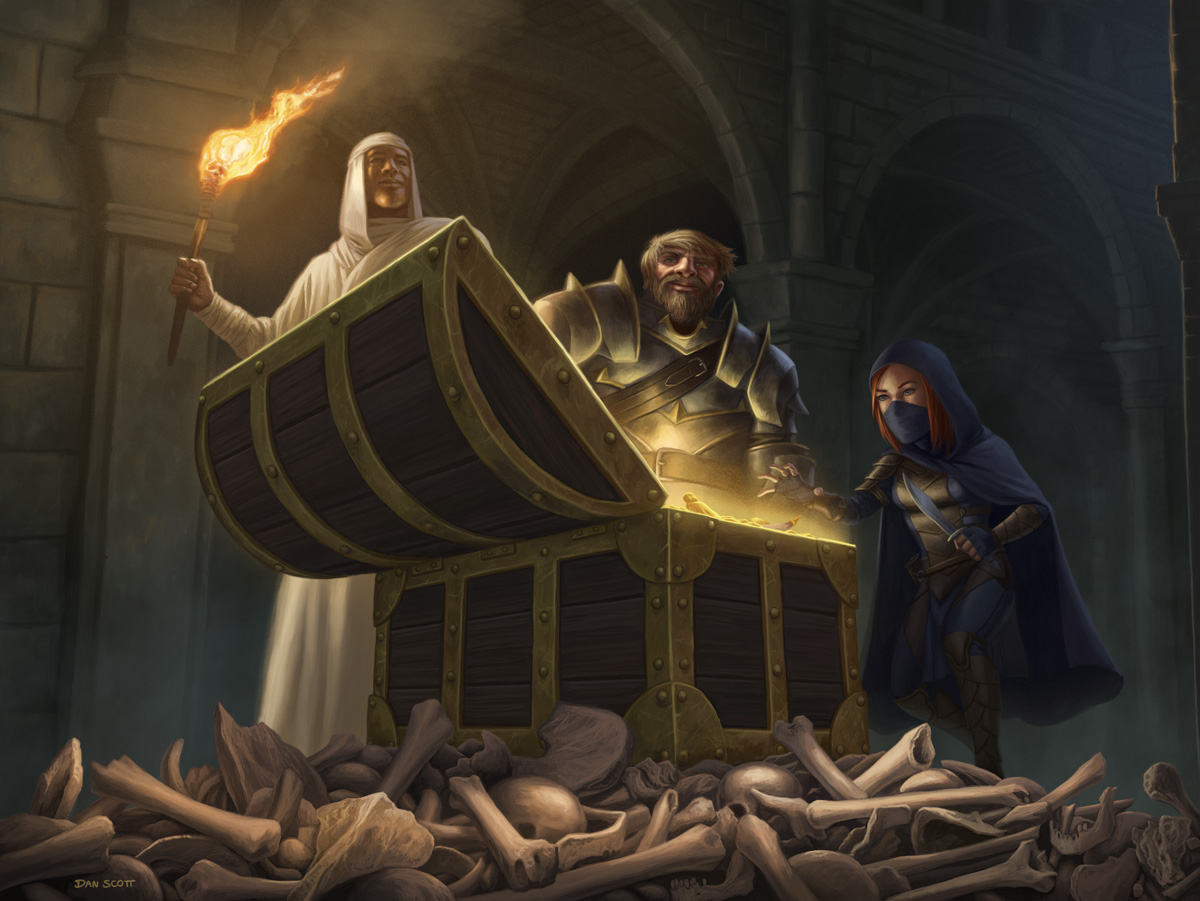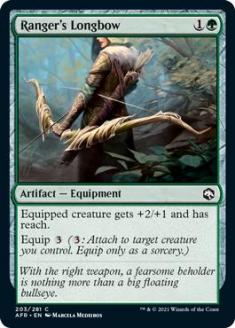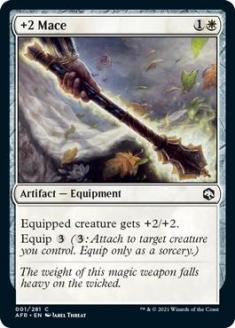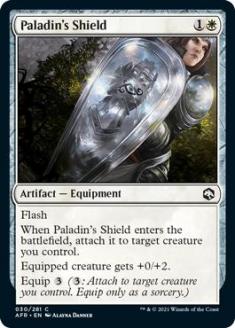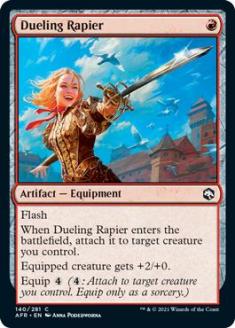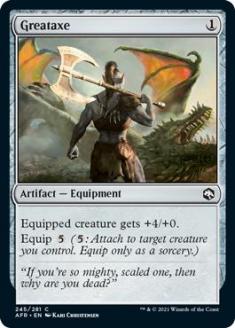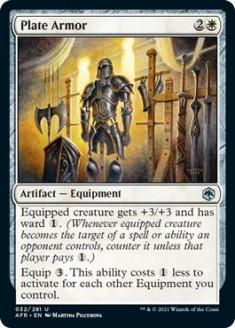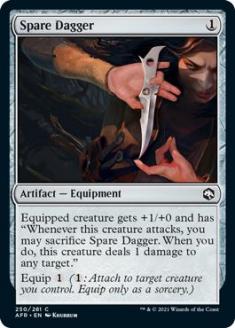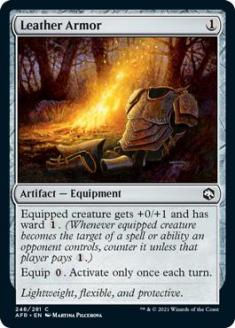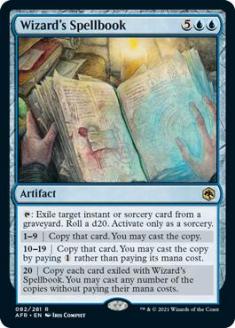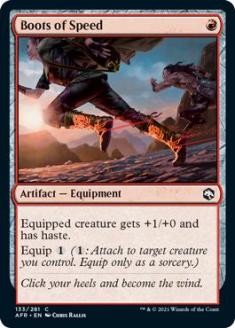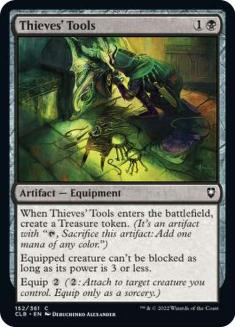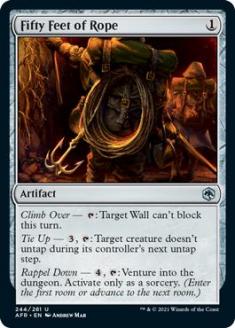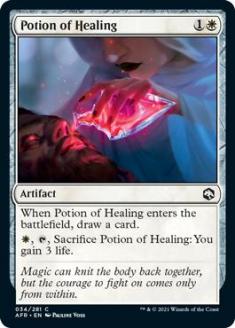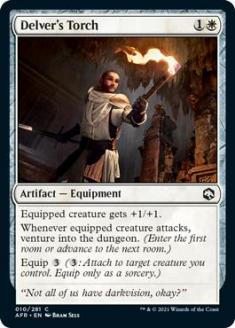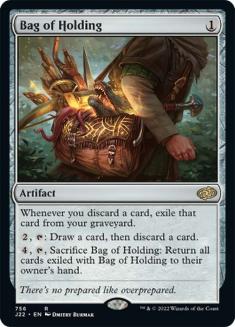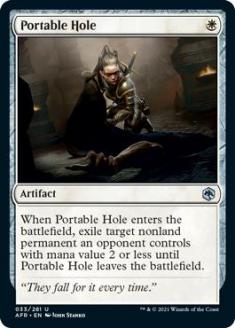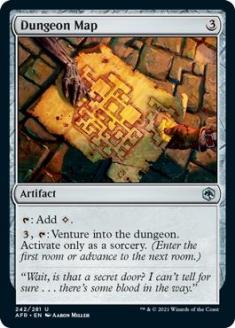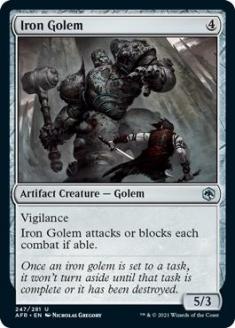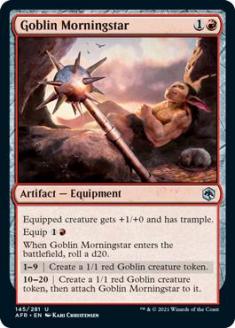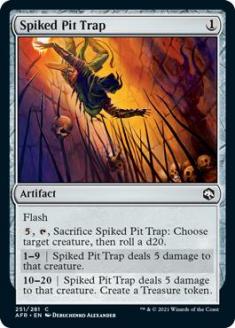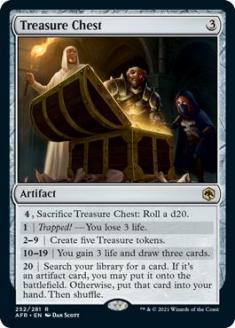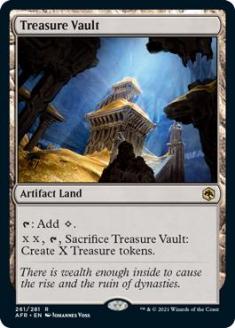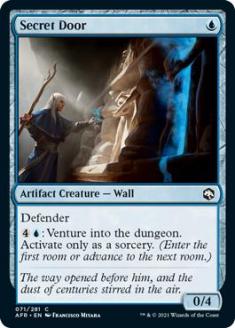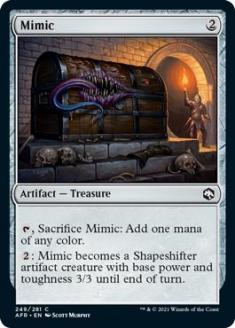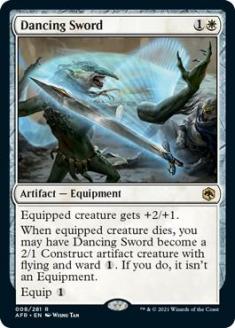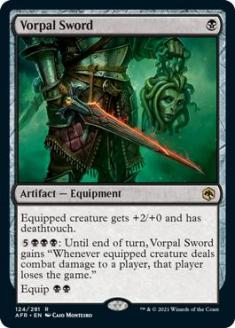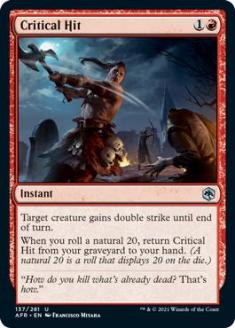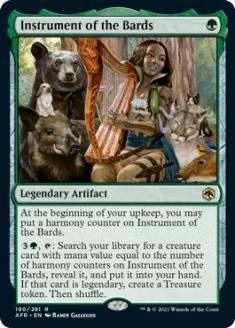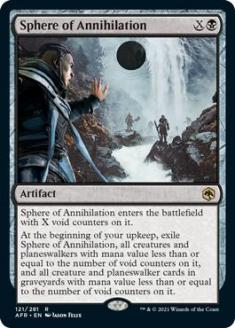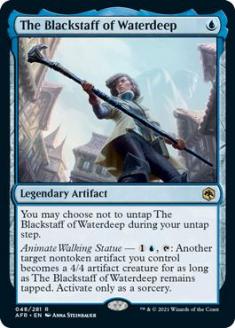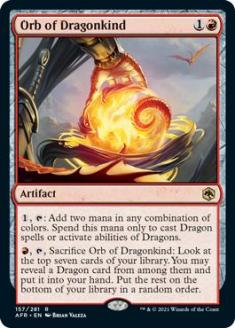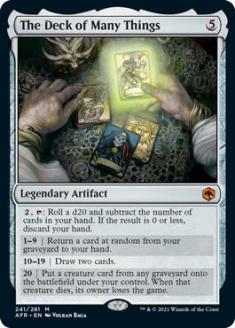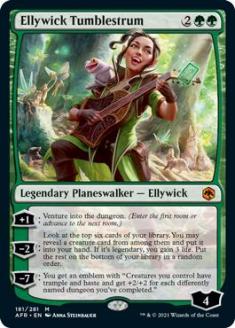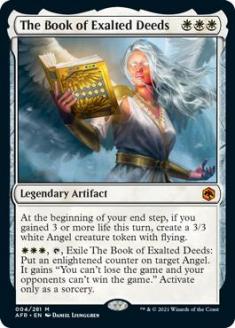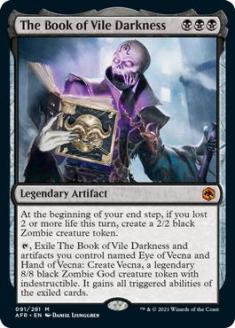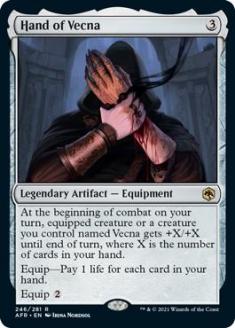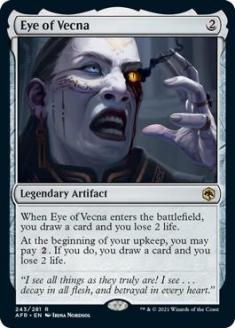Greetings, adventurer! During our last visit we spoke of the dragons that are a blight to our land. I thought the tales of their terrible might may have frightened you off yet you remain undeterred! If you’re still serious about tangling with a dragon, it would be wise for you and your companions to be well equipped! Fortunately you have come to the right place! Follow me; we can discuss payment on the way to my shop.
In previous articles, we covered legendary creatures, planeswalkers, and chromatic dragons. Now it’s time to savor the flavor of the artifacts in this set and, boy, is there a lot to cover! Collecting cool magical items and loot is one of the core parts of D&D and there are so many different kinds of items — from swords and bows to magical decks of cards!
Today I’m going to go over a couple of the artifacts in groups, give them an overall grade, and then pick the best of the bunch and tell you why I like it.
Arms & Armor
In D&D there are all sorts of different kinds of arms and armor, from bows and arrows to greataxes, and from leather armor to plate. As characters level up in the game, they may earn gold and be able to purchase more powerful items or they may find magical arms and armor such as a +2 Mace.
These items are all arms and armor, are Equipment, and are all rather unsurprising. Some of the artifacts even name the class they’re tied to, such as Ranger’s Longbow and Paladin’s Shield. These are all rather unassuming and straight forward. The armor increases toughness, the weapons increase power, and so on and so forth. There is, however one notable exception: Wizard’s Spellbook.
Arms & Armor Overall Grade: C
Best of the bunch: Wizard’s Spellbook
Full disclosure — wizard is my favorite class and therefore I am terribly and unabashedly biased here. In D&D, wizards must learn to cast spells through experimentation and rigorous study. They scribe all of their spells into a magical spellbook. They can also copy spells from other wizards’ spellbooks or arcane scrolls they find along their travels. One major difference between wizards and other arcane spellcasters is that, given enough time, resources, and experience, a wizard could learn nearly every arcane spell available to them. This gives a wizard an incredible amount of flexibility when it comes to preparing their spells, far more than any other arcane spellcaster. This is all thanks to their handy dandy spellbook. There is, of course, one drawback in that if a spellbook is lost or destroyed, they lose all of the spells contained within the book so wizards tend to safeguard their spellbooks or keep multiple copies well hidden, but the practice of copying a spellbook is as expensive as it is time consuming.
So let’s talk about the card Wizard’s Spellbook. It’s a blue artifact with the following ability:
1-9 | Copy that card. You may cast the copy.
10-19 | Copy that card. You may cast the copy by paying {1} rather than paying its mana cost.
20 | Copy each card exiled with Wizard’s Spellbook. You may cast any number of the copies without paying their mana costs.
This card is filled with flavor and allows for players to “copy” spells they have already cast into their spellbook with a chance of casting them later for less or no mana. There’s also a chance for the player to cast all of the spells in their spellbook for no mana! This card has a neat design and I really like the flavor.
Grade: A
Dungeoneering Equipment
So you’re armed and armored and now you need to venture into the dungeon. But what on earth do you take with you? Caltrops, a ten foot pole, an abacus, or perhaps 1,000 ball bearings? Okay, so these are some of the more random items you can choose to take with you into the dungeon, but you get the point (I will also point out that a few of these items are magical and might not be readily available at your local blacksmith shoppe).
The dungeoneering equipment items range from boots of speed used to increase your character’s movement through the dungeon to thieves’ tools and fifty feet of rope to get you into (and sometimes out of) areas where you are probably not supposed to be. Further items include a torch and map to help guide the way through the darkest dungeons to a potion of healing to help mend the wounds taken from the dangers of the dungeon.
The flavor of these items is better than the Arms and Equipment and the flavor text of several of these cards in particular is really good. I especially appreciate Delver’s Torch, as many creatures in D&D can see in the dark but many others can’t and have to rely on torchlight when exploring dungeons. There are two cards, both magical items, that really stand out to me on this list especially since they are so similar in D&D: Bag of Holding and Portable Hole.
Dungeoneering Gear Overall Grade: B
Best of the bunch: Bag of Holding and Portable Hole
In D&D, a Bag of Holding is like Mary Poppins handbag or Newt Scamander’s suitcase.

Okay, so a bag of holding cannot hold a whole laboratory, but it might be able to hold many of the contents. The point is that a bag of holding contains an extradimensional space for you to stash your stuff. You can reach in and pull out a ten foot pole, pack of arrows, or whatever else you may have stored in it. A portable hole on the other hand is some Wile E. Coyote nonsense.

The way it works is this: you have a fine black cloth that you place flat on a surface and it creates an extradimensional space that is ten feet deep. If a creature falls into the hole, it can attempt to climb out but if it’s not strong enough to make the climb, it will remain trapped in the hole if the owner picks it up off of the floor. If a creature is left sealed in the extradimensional space, it will begin to suffocate after ten minutes or so.
So… how do the cards stack up? Bag of Holding is a colorless artifact with the following abilities:
{2}, {T}: Draw a card, then discard a card.
{4}, {T}, Sacrifice Bag of Holding: Return all cards exiled with Bag of Holding to their owner’s hand.
While the card does allow you to store stuff and gives good card advantage, it sacrifices itself in order to open the bag (which doesn’t exactly fit with the lore of the card) but you’re stuffing a bunch of items into exile (essentially an extradimensional space) and then getting them back when you “open the bag”. So I guess this card is pretty flavor-filled. The flavor text is also pretty good:
Leave no treasure behind.
Bag of Holding Grade: B+
Portable Hole is a white artifact which has the following ability:
As we discussed earlier, portable hole works almost exactly like this and will trap a weak creature indefinitely. The flavor text is what sets this card apart for me.
“They fall for it every time.”
Portable Hole Grade: A
Side note: Now that we know how these two items work, this begs the inevitable question. What happens when you put a bag of holding inside a portable hole? The answer is similar to dividing by zero. Placing one item inside of the other tears a hole in reality, destroying both magical items, and ripping everything within a ten foot radius through the tear and dispersing those objects and beings to a random location on the astral plane. Just don’t do it.
Dungeon Hazards and Features
Treasure is a feature right? That’s one of the main reasons the adventurers delve into dungeons — to find treasure! But here there are monsters, traps, and treachery so be prepared to fight for those riches! Perhaps you come across a goblin wielding a Morning Star or narrowly avoid a spiked pit trap only to come face to face with a mighty Iron Golem who is guarding a secret door to a hidden treasure vault. As you finally approach your prize, a treasure chest you find is actually a mimic in disguise!!! Roll initiative!
All of these items are very flavorful and are exactly what I would expect to see as dungeon centerpieces. The only card that’s a little weak for me is Iron Golem, but it’s not enough to bring the rest of the list down too much. The real flavor winner here is Mimic.
Dungeon Hazards and Features Overall Grade: B+
Best of the Bunch: Mimic
Let’s talk about mimics for a second. A mimic is a shapeshifting predator that can assume the form of nearly any inanimate object to better ambush its prey. Mimics are utterly terrifying as they could be anywhere and disguised as anything — a treasure chest, a door, a table, a toaster… wait they don’t have those in D&D… but you get the idea. Everyone remembers their first tangle with a mimic, especially if one of their friends ends up getting eaten by a chair!
So how does this card measure up? Mimic is a colorless artifact – Treasure with the following ability:
{2}: Mimic becomes a Shapeshifter artifact creature with base power and toughness 3/3 until end of turn.
So not only does it have the Treasure typing but it acts like a treasure in every way until you need it to become a creature in which case it turns into a shapeshifter! Brilliant! The card may not be overly powerful but it’s incredibly flavorful! I love this card but my only critique is no flavor text. Something like…
“Look over there, an unguarded treasure chest, let’s crack it open!”
Last words of Waylorn the Martyr
Would have been fitting. Now if you don’t mind, I’m going to go mimic-proof the house.
Mimic Grade: A-
Wonderous Items
Up to this point we have covered our artifacts in groups but this group of artifacts is truly special. This section contains wondrous items, one of a kind legendary artifacts, and other objects of no small renown. These items are powerful and many of them are represented as legendary artifact cards, and for good reason, as many of these wondrous items are well known throughout the Forgotten Realms. I really like how the art of these cards is inspired by the art from the D&D 5e Dungeon Master’s Guide.
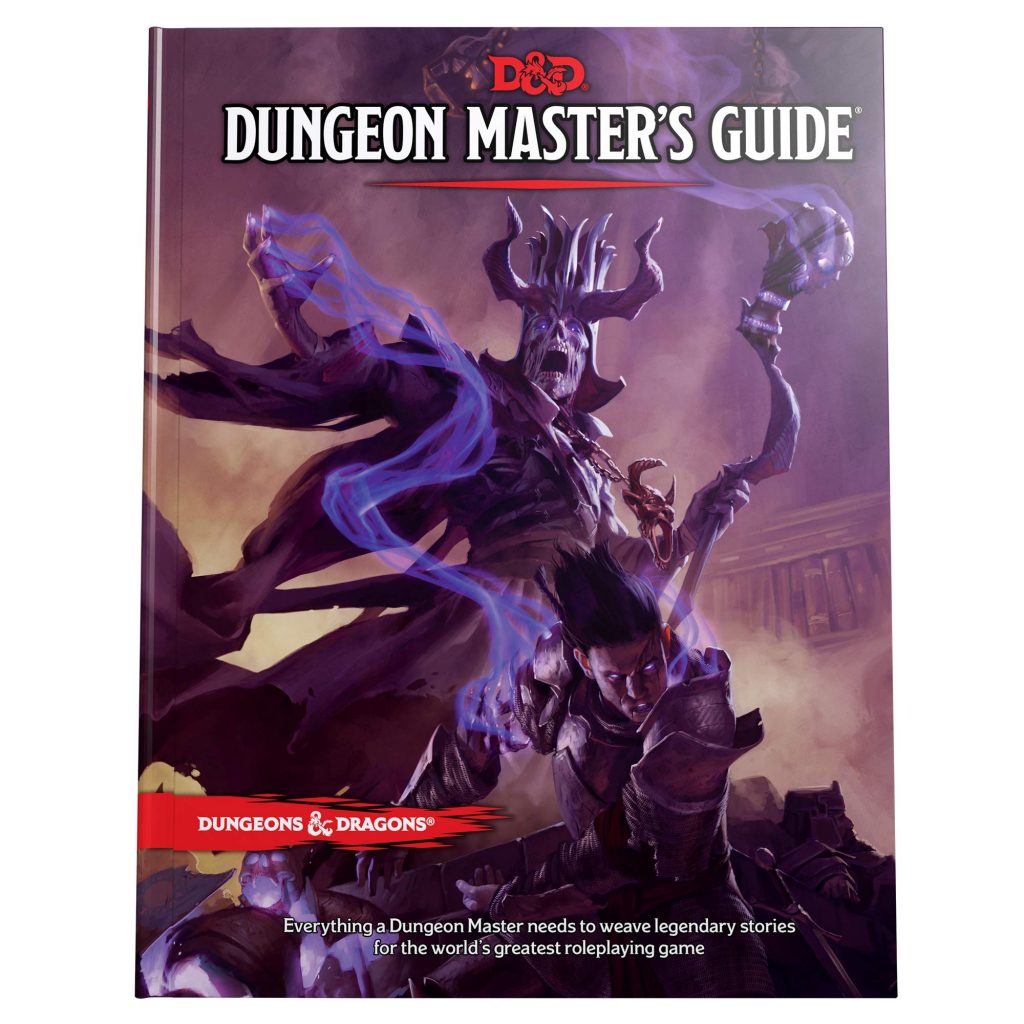
Dancing Sword
First up we have Dancing Sword. This is a neat magical item. It’s, for all intents and purposes, a magical sword but you can also toss the sword into the air and speak a command word that causes the sword to animate and fly. You can then direct the sword to fly up to 30 feet away and attack an enemy. After four such attacks, the sword flys back to your hand.
Who wouldn’t want a sweet flying sword? Now, let’s look at the card design. Dancing Sword is a colorless Equipment with:
When equipped creature dies, you may have Dancing Sword become a 2/1 Construct artifact creature with flying and ward {1}. If you do, it isn’t an Equipment.
Equip {1}
This artifact is an Equipment and can be used as a regular sword just like in D&D. When the creature it is attached to dies, it becomes a Construct artifact creature with flying. The only flavor fail here for me is that the card cannot be animated while the creature is alive. I don’t know about you but I’m not keen on the idea of dying in order to use my sweet magic flying sword!
Grade: B
Vorpal Sword
Next up we have one of the deadliest weapons in D&D, the Vorpal Sword! This sword can come in many forms and can be any kind of sword that can deal slashing damage. The weapon deals additional damage and ignores any resisting to slashing damage. The scariest part of this weapon is when you roll a 20 to hit — this causes you to actually decapitate your enemy!
So how does the card measure up to this gruesome weapon? Vorpal Sword is a black Equipment with the following ability:
{5}{B}{B}{B}: Until end of turn, Vorpal Sword gains “Whenever equipped creature deals combat damage to a player, that player loses the game.”
Equip {B}{B}
The art is a testament to the deadly effectiveness of the weapon as it depicts a freshly decapitated medusa, a powerful foe in D&D. The Vorpal Sword is deadly to all except indestructible creatures and, if the game goes long enough, a creature equipped with a Vorpal Sword can eliminate a player as well!
Yikes! It seems nothing is safe from the Vorpal Sword!
We should treat this card with the same respect we do in my D&D game and ban it! (Just kidding! Kind of. . .)
Grade: A
Instrument of the Bards
So this item is actually seven magical items in one. These are special magical instruments that are superior to other instruments in nearly every possible way. The seven Instruments of the Bards are as follows:
- Anstruth harp
- Canaith mandolin
- Cil lyre
- Doss lute
- Fochlucan bandore
- Mac-Fuirmidh cittern
- Ollamh harp
Each of these items varies in rarity and allows the bard to cast a variety of powerful spells. An Instrument of the Bards also increases the power of the user’s charm spells. The Instrument of the Bards depicted in the art of the card appears to be the Ollahm harp which makes sense since it’s the only legendary Instrument of the Bards. The Ollamh harp allows its user to cast spells such as invisibility, confusion, and several powerful elemental spells including control weather and firestorm. As you can see, an Instrument of the Bards is a powerful item indeed!
How does a legendary artifact that can do so much in D&D translate into a single card? The simple answer is it can’t. And I will explain why. But first the card! Instrument of the Bards is a green legendary artifact with the following ability:
{3}{G}, {T}: Search your library for a creature card with mana value equal to the number of harmony counters on Instrument of the Bards, reveal it, and put it into your hand. If that card is legendary, create a Treasure token. Then shuffle.
Sounds like a lot of searching for creatures and not a lot of searching or casting elemental spells. The Harmony counter is a nice touch and flavorful, as is the Treasure token. Toss a coin to your bard!
Grade: C
Sphere of Annihilation
A sphere of annihilation is one of the most dangerous magical items in existence due to its destructive power. It’s a 2-foot-diameter black hole in the multiverse. It’s kept stable by a strong magical field which surrounds it. All matter that passes through the sphere is obliterated with no hope of recovery. This includes living and non-living matter, including magical items, so attacking one with your sword would be unwise. It takes a true master of the arcane arts and a strong force of will to manipulate a sphere of annihilation and send it towards your enemies. This powerful artifact is featured in a Tomb of Horror and Tomb of Annihilation. Both modules are known for being unkind to players and unsurprisingly causing a lot of character deaths.
So does the sphere of annihilation’s destructive prowess shine through here? I think so, but let’s take a closer look. Sphere of Annihilation is a black artifact with the following ability:
At the beginning of your upkeep, exile Sphere of Annihilation, all creatures and planeswalkers with mana value less than or equal to the number of void counters on it, and all creature and planeswalker cards in graveyards with mana value less than or equal to the number of void counters on it.
Wow. . .that is powerful. The sphere doesn’t destroy creatures and planeswalkers — it exiles them! Poof! Gone forever! And it hits the graveyard too! I think this really encapsulates how terrifying this magical item really is and how hard it can be to control if you don’t know what you’re doing as it also exiles your own stuff too. My only complaint is that it doesn’t destroy artifacts and I feel like it is a bit of a flavor fail here.
Other than that, I have no complaints; just keep that sphere away from me!
Grade: B+
The Blackstaff of Waterdeep
The Blackstaff is an interesting one as it’s both an item and a title for a powerful line of wizards in the city of splendors known as Waterdeep. There’s an incredible amount of lore about the wizard known as “Blackstaff” which could be an article all on its own. The art of this card depicts his successor, the seventh in the Blackstaff line, Vajra Safahr wielding the blackstaff. Vajra is featured in the module Waterdeep Dragonheist. The “Blackstaff” is also able to animate the eight colossal Walking Statues of Waterdeep, powerful guardians that aid in the defense of Waterdeep.
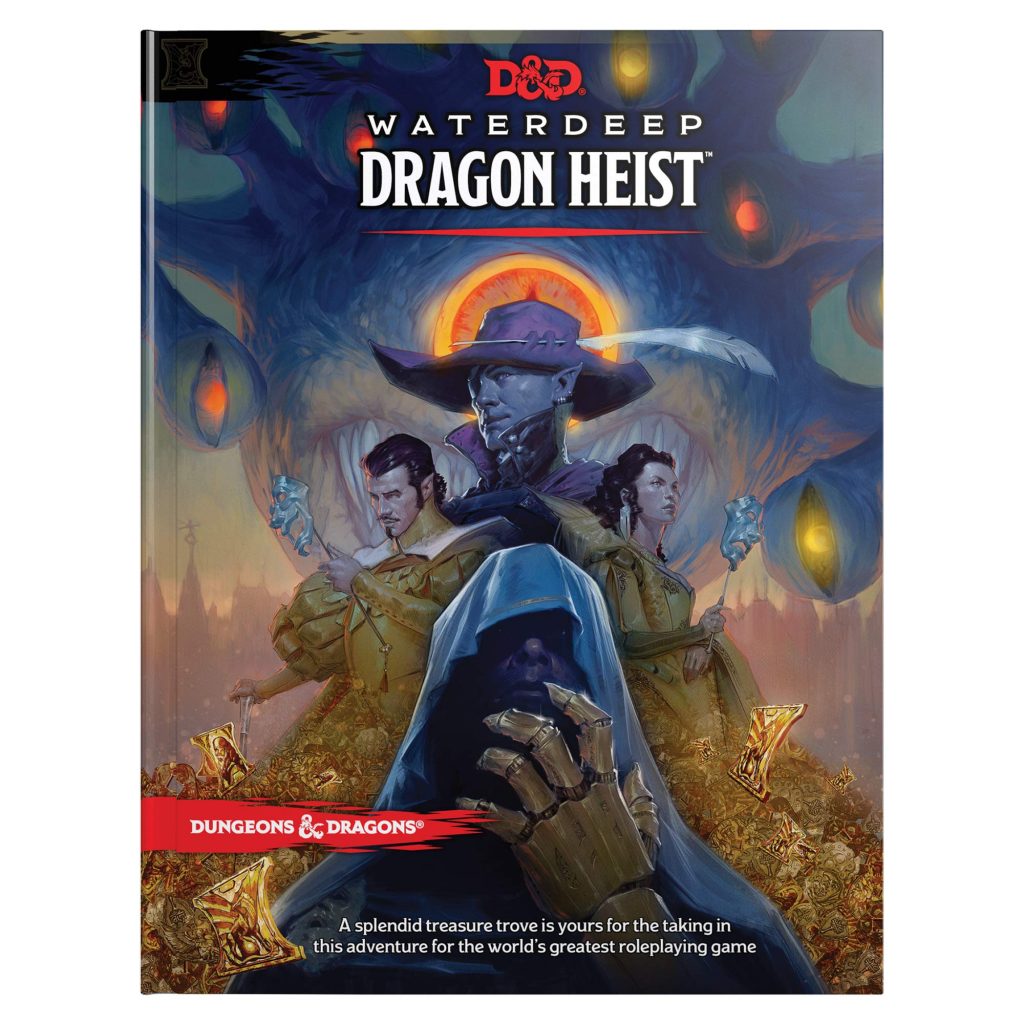
At its heart the “BlackStaff” is a Staff of Power, which allows the user to cast a variety of powerful spells. It can also be used as a magical quarterstaff and buffs the user’s defense as well as their spellcasting abilities. If broken, it releases all of its magic and may transport the person who destroyed the staff to a random plane.
Let’s take a look at the card. The Blackstaff of Waterdeep is a blue legendary artifact with the following ability:
Animate Walking Statue — {1}{U}, {T}: Another target nontoken artifact you control becomes a 4/4 artifact creature for as long as The Blackstaff of Waterdeep remains tapped. Activate only as a sorcery.
I’m happy to see the current “Blackstaff” title bearer depicted in the image, along with the signature staff. I also like the reference to the Walking Statues of Waterdeep that are animated by the Blackstaff; however, they are supposed to be titanic in size and a 4/4 just doesn’t feel colossal to me. If it were an 8/8 I might feel differently. The art is what saves it for me and even so this card still manages to fall a little short in my opinion.
Grade: C
Orb of Dragonkind
In ancient times, on another world, men and elves were beset upon by evil dragons. The war was long and costly. When all hope seemed lost, the most powerful wizards in the land came together and forged five Orbs of Dragonkind. Each dragon orb was bound with the essence of an evil dragon. The Orbs of Dragonkind were used to lure the evil dragons to one of the five locations where they could be destroyed by the wizards’ powerful magic spells.
Ages have passed and only three of the Orbs of Dragonkind are said to have survived. Interestingly the Orb of Dragonkind depicted in the book is green while the Orb of Dragonkind depicted on the card is red so who knows what color the third one might be?
The Orbs of Dragonkind are now ancient and their magic has warped and twisted. It allows the user to cast several spells and can still be used to compel all dragons within a 40 mile radius to come to the user’s location. There is however a catch for those of weak will. When you attune to the item’s magic, you enter a battle of wills with the essence of the dragon trapped within the orb. If your character fails this battle of wits, your character becomes beholden to the orb’s wishes.
So obviously this is a pretty lore-filled artifact, but how does the card measure up? Orb of Dragonkind is a red artifact with:
{R}, {T}, Sacrifice Orb of Dragonkind: Look at the top seven cards of your library. You may reveal a Dragon card from among them and put it into your hand. Put the rest on the bottom of your library in a random order.
This is an artifact that’s very dragon focused and it can be sacrificed to draw dragons from your deck into your hand and it hastens the casting of dragon abilities. This artifact is spot on! I do wish they would have included the corrupting effect or even some flavor text though.
Grade: A-
The Deck of Many Things
No other artifact in D&D has more of a reputation for causing as much chaos as The Deck of Many Things. The deck contains a number of magical cards made of ivory or vellum. When you draw from The Deck of Many Things, you must decide how many cards you wish to draw. Once drawn, the magic of the cards takes effect. The effects very wildly and include gaining the service of a knight, losing an experience or even all of your possessions, gaining a bunch of money and gems, increasing your intelligence, summoning an avatar of death, gaining a rare magical item, or having your soul trapped in an object in a location that cannot be divined by normal means. Or if you’re super lucky, as was the case with Ellywick Tumblestrum, you could earn a chance to wish for anything your heart desired with no strings attached.
Nearly every player who has come across The Deck of Many Things has a story to tell. Some of them are good, some are bad, but all of them are memorable. This artifact is legendary in the lore of D&D because no matter what you draw, there will always be a story to follow. The question you must ask yourself is — is it worth the risk?
So how does the card measure up? Let’s take a look. The Deck of Many Things is a colorless artifact with:
1—9 | Return a card at random from your graveyard to your hand.
10—19 | Draw two cards.
20 | Put a creature card from any graveyard onto the battlefield under your control. When that creature dies, its owner loses the game.
First of all, the art is super flavorful and shows the Jester as the card which has been drawn, forcing a draw of two more cards from The Deck of Many Things. It also shows The Skull which summons an avatar of death and The Sun which causes you to gain a ton of XP and a random wondrous item.
The abilities are a good mix of helpful and detrimental and the final ability can be incredibly risky or not. Maybe I’m greedy and want more chaos but I want this card to have a greater spread of abilities. The question I have for you is this — if given the chance, would you draw from the Deck of Many Things?
Grade: B+
The Book of Exalted Deeds
A book that contains all that is just and good within the multiverse. No single faith can claim The Book of Exalted Deeds for its own and the book moves about the multiverse spreading its good works wherever it goes. Studying the book takes 80 hours and increases your character’s wisdom, allows you to cast more powerful divine spells, and grants your character a protective halo that sheds light and protects your character against evil creatures. After being read, the book vanishes to continue spreading good throughout the multiverse.
The Book of Exalted Deeds is a white legendary artifact with the following ability:
{W}{W}{W}, {T}, Exile The Book of Exalted Deeds: Put an enlightened counter on target Angel. It gains “You can’t lose the game and your opponents can’t win the game.” Activate only as a sorcery.
I feel like this card really evokes the flavor of this powerful book! It takes some time to get online and exiles itself when you “read” it. I especially like the last ability which grants you an enlightened counter and prevents you from losing the game. This card proves that good always triumphs over evil!
Grade: A
The Book of Vile Darkness, Hand of Vecna, and Eye of Vecna
I’m going to evaluate these three cards together as the lore for them is pretty interconnected. Each of these artifacts have a terrible cost in order to use them.
The Book of Vile Darkness is the antithesis of The Book of Exalted Deeds. Legend states that it was penned by Vecna, the god of liches himself. In his lifetime, Vecna was a powerful wizard who sought the ability to extend his life through unnatural and dark processes and became one of the most powerful liches of his time. Eventually, he ascended to godhood and became the god of all liches. The Book of Vile Darkness contains every corrupt ritual, vile concoction, deranged experiment, and maddened ramblings the lich could collect and bind to a book. It also includes the process by which a spellcaster can become an undead lich. The book is so evil that animals will not approach it, plants wither in its presence, and if left atop a stone pedestal, it will grind the stone to dust.
To use the Eye of Vecna, you must first pluck out your own eye and replace it with the Eye of Vecna. The eye then grafts itself to your skull and remains until you die. It grants the user the ability to pierce any illusion or glamor and see the world as it truly is. The eye can also be used to grant the wearer x-ray vision. The eye also grants you the ability to cast a limited number of spells. Each time you cast a spell using the eye, there’s a chance that Vecna consumes your soul and takes possession of your body. Removing the eye after it has been grafted is fatal.
To use the Hand of Vecna, you must first lop off your left hand and press the withered hand to your stump. The hand grafts itself to your arm and becomes a fully functioning appendage. The Hand of Vecna boosts your strength to an incredible degree. It also adds cold damage to your attacks and it grants the user the ability to cast powerful spells. Each time you cast a spell, the Hand of Vecna encourages the user to commit evil acts. Removing the hand after it has been grafted is fatal.
Now that we know what these vile artifacts do, let’s carefully look at the cards:
The Book of Vile Darkness is a black legendary artifact with:
{T}, Exile The Book of Vile Darkness and artifacts you control named Eye of Vecna and Hand of Vecna: Create Vecna, a legendary 8/8 black Zombie God creature token with indestructible and all triggered abilities of the exiled cards.
The Eye of Vecna is a colorless artifact with:
At the beginning of your upkeep, you may pay {2}. If you do, you draw a card and you lose 2 life.
The Hand of Vecna is a colorless artifact with:
Equip—Pay 1 life for each card in your hand.
Equip {2}
I really like how these artifacts synergize much like they do in D&D. The Eye of Vecna grants the user additional insight for a price, the Hand of Vecna boosts the user’s strength and has a terrible price to pay to use it. Finally, The Book of Vile Deeds includes instructions on how to summon zombies and even Vecna himself! I couldn’t ask for more flavor from the artifacts of Vecna! They are vile!
Grade: A
Being an adventurer means having the right equipment for the job and I would say that Adventures in the Forgotten Realms definitely hits the mark for me! The flavor is rich and there are so many wonderful magical items to be had. Make sure to take a bag of holding too and leave no treasure behind, adventurer! ‘Til next time!
I hope you enjoyed this article. It was truly a labor of love. If you are a Dungeons & Dragons fan like myself and want to read more of my musings about dungeons, dragons, and Game Master advice, check out my blog.

